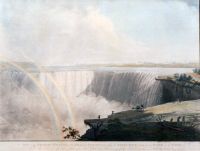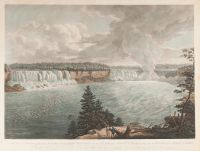Views of Niagara Falls (Engraving)
A View of the Western Branch of the Falls of Niagara, Taken from the Table Rock, Looking Up the River, Over the Rapids
Artist/Maker: John Vanderlyn
Created: 1804
Origin/Purchase: London
Materials: engraving
Dimensions: 20 5/16" × 29 3/4" (51.6 × 75.5 cm)
Location: Dining Room
A Distant View of the Falls of Niagara, Including Both Branches with the Island and Adjacent Shores, Taken from the Vicinity of the Indian Ladder
Artist/Maker: John Vanderlyn
Created: 1804
Dimensions: 25 1/8" × 32 1/2"
Location: Dining Room
Historical Notes: Jefferson included the "Cascade of Niagara" among America's natural wonders "worth a voiage across the Atlantic," and he displayed these two engravings in the Dining Room at Monticello alongside images of the Natural Bridge and Harper's Ferry.[1] Jefferson's knowledge of Niagara was only through written descriptions and early engravings. He owned what is thought to be the first engraved image of the falls, which was contained in the missionary-explorer Louis Hennepin's Nouvelle Découverte d'un très grand Pays situè dans l'Amerique, published in 1807.[2]
John Vanderlyn was an American-born artist who with the help of his patron Aaron Burr (who later was Jefferson's vice president) studied painting with Gilbert Stuart and then traveled to Paris to study art. After his return to America in 1801 Vanderlyn planned to support himself by selling views of Niagara Falls. He made a series of sketches at the falls in late 1801 and completed his first painting, A Distant View of the Falls of Niagara, in 1802. He finished the second work, A View of the Western Branch of the Falls of Niagara, while on a second trip to Paris.[3]. There he met James Monroe and the two traveled together to London, where Vanderlyn engaged the engravers Frederick Lewis and J. Merigot.[4]
Vanderlyn began collecting subscriptions for the engravings in 1803; Jefferson paid $20 for both prints on March 2.[5] The engravings were completed in London in 1804, and Vanderlyn wisely decided against dedicating the prints to Burr, who conspired against Jefferson and was replaced as vice president that same year by George Clinton.[6] The venture proved on the whole to be unprofitable largely due to mismanagement. Though the subscription list was lost, Jefferson received his two prints, framed and glazed, in December 1805.[7] Their whereabouts today are unknown.
- Text from Stein, Worlds, 188
References
- ^ Jefferson to Maria Cosway, October 12, 1786, in PTJ, 10:447. Transcription available at Founders Online. See also Jefferson to Angelica Schuyler Church, February 17, 1788, in PTJ, 12:600-01. Transcription available at Founders Online. Catalogue.
- ^ Sowerby, 4066; Jeremy Elwell Adamson, "Nature's Grandest Scene in Art," in Niagara: Two Centuries of Changing Attitudes, authors and contributors Adamson et al. (Washington, D.C.: The Corcoran Gallery of Art, 1985), 17.
- ^ Adamson, "Nature's Grandest Scene," 25-28.
- ^ John Davis Hatch, "John Vander Lyn's Prints of Niagara Falls," Antiques 138 (December 1990): 1253-55.
- ^ Jefferson, March 2, 1803, in MB, 2:1093. Transcription available at Founders Online.
- ^ Vanderlyn to John B. Prevost, February 20, 1804, cited in Hatch, "Vander Lyn's Prints," 1257.
- ^ Vanderlyn to Jefferson, December 31, 1805, Thomas Jefferson Papers, Library of Congress. Recipient's copy available online. Transcription available at Founders Online.

